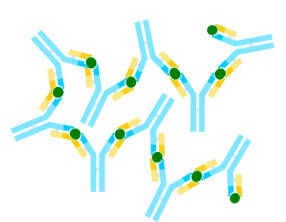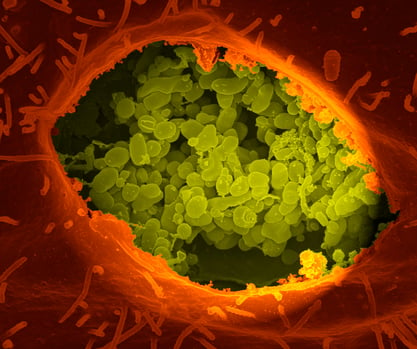
A team of biochemists at UCLA have created a novel system of converting glucose into highly useful chemical compounds, such as those needed to create biofuels and pharmaceuticals. Previous research endeavors relied on using cells to convert sugar into desired compounds. This has been difficult to achieve because cells would rather use sugar for their own natural uses, such as building proteins and cell walls. The UCLA biochemists have recently developed a way to achieve the conversion of glucose into desired compounds- without using cells.
Read More
Tags:
CA,
University of California Los Angeles,
Los Angeles,
Biochemistry,
chemistry research,
Chemistry,
LAVS,
UCLA,
Biotechnology Vendor Showcase,
2016,
Western,
glucose
 (Image courtesy of Cacophony via Wikimedia Commons)
(Image courtesy of Cacophony via Wikimedia Commons)
The Knight Cancer Institute at Oregon Health and Science University, a world-leader in cancer research, recently accomplished raising $1 billion in funding to help support the groundbreaking life science research being conducted at the center.
Read More
Tags:
new research building,
Oregon Health and Science University,
Northwest,
cancer research,
OR,
OHSU,
Portland,
2016,
BioResearch Product Faire,
Western,
Knight Cancer Institute

The Comprehensive Cancer Center at the University of Michigan, Ann Arbor is one of only 45 comprehensive cancer centers in the United States, and provides cutting-edge cancer research. Researchers from 48 different university departments and 9 schools work together in the cancer center to find answers to some of the toughest questions that scientists face when learning about cancer. The university and Cancer Center will soon be expanding their research capabilities thanks to a generous $17.5 million donation from philanthropists Madeline and Sydney Forbes.
Read More
Tags:
University of Michigan,
Midwest,
cancer research,
Ann Arbor,
MI,
UMich,
new funding,
2016,
BioResearch Product Faire,
Comprehensive Cancer Center,
Forbes Institute for Cancer Discovery,
Madeline and Sidney Forbes

Small-cell lung cancer (SCLC) makes up about 10 - 15% of all lung cancer diagnoses, and is caused by smoking and inhaling second-hand smoke. This is an aggressive type of cancer that spreads quickly, and recurs extremely frequently after patients undergo chemotherapy treatments. Treatments for SCLC have not changed much in the past 30 years, but a team of researchers led by the Fred Hutchinson Cancer Research Center in Seattle has been investigating potential new therapy methods for the cancer and recently uncovered a gene that has the potential to be used in biology-based treatments for SCLC. (Image courtesy of Lindsay Fox via Wikimedia Commons and EcigaretteReviewed)
Read More
Tags:
Fred Hutchinson Cancer Research Center,
WA,
cancer research,
Seattle,
Hutch,
2016,
Fred Hutch,
BioResearch Product Faire,
Western,
small-cell lung cancer,
L-Myc,
SCLC
 Downy mildew, a fungus-like pathogen, is a major threat to crops around the country. Cucurbit crops like squash, cucumber, and melons suffered from a downy mildew outbreak in 2004 that initially only affected crops in the southeastern United States but later spread throughout the Midwestern region, and is still affecting these foods today. Michigan is a state where crops are greatly affected by downy mildew. A team of researchers from Michigan State University will be leading a $2.3 million project, granted by the U.S. Department of Agriculture, to develop methods to manage downy mildew. (Image courtesy of Kerstin Ellen Hantschel via Wikimedia Commons)
Downy mildew, a fungus-like pathogen, is a major threat to crops around the country. Cucurbit crops like squash, cucumber, and melons suffered from a downy mildew outbreak in 2004 that initially only affected crops in the southeastern United States but later spread throughout the Midwestern region, and is still affecting these foods today. Michigan is a state where crops are greatly affected by downy mildew. A team of researchers from Michigan State University will be leading a $2.3 million project, granted by the U.S. Department of Agriculture, to develop methods to manage downy mildew. (Image courtesy of Kerstin Ellen Hantschel via Wikimedia Commons)
Read More
Tags:
Michigan State University,
Midwest,
agriculture,
new research funding,
MI,
East Lansing,
MSU,
2016,
BioResearch Product Faire,
vegetable crops,
downy mildew
 Antibodies are essential for keeping the body healthy, as they are produced in the immune system and sent to fight harmful substances. Since they are essential for fighting off unwanted antigens in the body, antibodies are a hot topic that researchers are constantly studying. Recently, a research team from Duke University developed an antibody that specifically targets cancer cells, providing a possible new immunotherapy for cancer. (Image of antibody-antigen complex courtesy of Alejandro Porto via Wikimedia Commons)
Antibodies are essential for keeping the body healthy, as they are produced in the immune system and sent to fight harmful substances. Since they are essential for fighting off unwanted antigens in the body, antibodies are a hot topic that researchers are constantly studying. Recently, a research team from Duke University developed an antibody that specifically targets cancer cells, providing a possible new immunotherapy for cancer. (Image of antibody-antigen complex courtesy of Alejandro Porto via Wikimedia Commons)
Read More
Tags:
Duke University,
cancer research,
Durham,
NC,
Duke,
Antibodies,
BioResearch Product Faire,
cancer therapy,
eastern,
CFH
 Researchers around the world are constantly studying ways to create new treatment methods to fight cancer. With so many different forms of cancer, using one treatment method is not always effective for everyone battling this disease. Recently, a team of scientists in Chicago teamed up to create a new treatment method. Researchers from the University of Chicago and the biotechnology company Evelo Biosciences have partnered to develop a new microbiome-based immunotherapy treatment method for fighting cancer.
Researchers around the world are constantly studying ways to create new treatment methods to fight cancer. With so many different forms of cancer, using one treatment method is not always effective for everyone battling this disease. Recently, a team of scientists in Chicago teamed up to create a new treatment method. Researchers from the University of Chicago and the biotechnology company Evelo Biosciences have partnered to develop a new microbiome-based immunotherapy treatment method for fighting cancer.
Read More
Tags:
Midwest,
microbiome,
immunotherapy,
University of Chicago,
cancer research,
Chicago,
Front Line event,
IL,
UChicago,
2016,
BioResearch Product Faire,
cancer therapy,
Evelo Biosciences,
microbiome immunotherapy
 Neuroscience and genetics are two important topics life scientists are consistently studying. Researchers from UC Davis found a promising treatment for Huntington's Disease, while UC San Francisco was awarded $185 million to build a new neuroscience research institute. Recently on the East Coast, a team of researchers from the Columbia University Medical Center discovered a new neurodevelopmental syndrome as well as the genetic makeup of the mutations that cause the syndrome. (Image courtesy of Allen Ajifo via Wikimedia Commons)
Neuroscience and genetics are two important topics life scientists are consistently studying. Researchers from UC Davis found a promising treatment for Huntington's Disease, while UC San Francisco was awarded $185 million to build a new neuroscience research institute. Recently on the East Coast, a team of researchers from the Columbia University Medical Center discovered a new neurodevelopmental syndrome as well as the genetic makeup of the mutations that cause the syndrome. (Image courtesy of Allen Ajifo via Wikimedia Commons)
Read More
Tags:
Northeast,
Columbia University,
Neuroscience,
Columbia,
Genetics,
Neurology,
NY,
Columbia University Medical Center,
2016,
BioResearch Product Faire,
neurodevelopmental syndrome
Q fever, an infectious disease caused by the bacteria Coxiella burnetii, is common among livestock such as cattle, sheep and goats. The bacteria can be transmitted to humans through the inhalation of barnyard dust that is contaminated with animal excretion containing the bacteria. Along with passing from livestock to humans, Q fever has been aerosolized in the past and used for biological warfare.

(Image Courtest of Wikimedia Commons and the National Institutes of Health)
Read More
Tags:
CA,
vaccine research,
infectious diseases,
NIH funding,
UCI,
UC Irvine,
2016,
BioResearch Product Faire,
Western,
Coxiella burnetii,
Q Fever
Michigan State University is a leading research institution, with hundreds of life science researchers conducting cutting-edge research throughout the university's dozens of research centers, buildings, and departments. Thanks to 2 recent donations totaling $15 million, the university will expand its research space in the coming years by constructing a new research building in Grand Rapids.
Read More
Tags:
Michigan State University,
Midwest,
BioResearch Product Faire Event,
MI,
East Lansing,
MSU,
new Building,
new funding,
2016,
Grand Rapids Research Center








 Researchers around the world are constantly studying ways to create new treatment methods to fight cancer. With so many different forms of cancer, using one treatment method is not always effective for everyone battling this disease. Recently, a team of scientists in Chicago teamed up to create a new treatment method. Researchers from the
Researchers around the world are constantly studying ways to create new treatment methods to fight cancer. With so many different forms of cancer, using one treatment method is not always effective for everyone battling this disease. Recently, a team of scientists in Chicago teamed up to create a new treatment method. Researchers from the 
